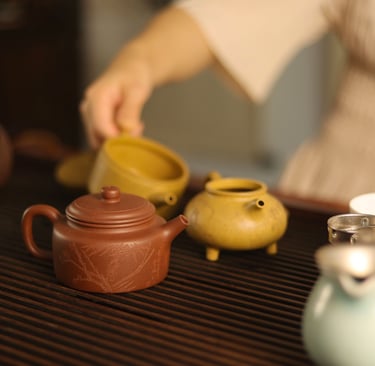6 Tea Table Mistakes You’re Probably Making (And How to Fix Them)
Discover 6 common tea table mistakes you might be making and how to fix them. Improve your tea etiquette, serve with confidence, and create a better tea experience!


6 Tea Table Mistakes You’re Probably Making
TEAPOTARTISAN
You pour tea for a guest, fill their cup to the brim, and think you’re being hospitable. Or maybe you grab tea leaves with your bare hands, thinking it’s no big deal. Turns out, these small actions can be seen as impolite in traditional tea culture.
If you enjoy tea—whether casually at home or when hosting guests—you’ll want to avoid these common tea table mistakes. Let’s break them down and fix them so your tea sessions are smooth, enjoyable, and respectful.
6 Subtle Tea Table Mistakes That Make You Look Rude
1. Not Pre-Warming the Teaware
Think your cups are already clean? That’s not the point.
Before brewing tea, experienced tea hosts rinse the teaware with hot water. This does two things:
Removes any dust or odors from the cups, ensuring a purer tea experience.
Warms up the teaware, which helps bring out the aroma and flavor of the tea.
Skipping this step might make you seem inattentive to detail—especially when serving guests. It’s a small ritual that shows care and respect.
2. Grabbing Tea Leaves with Your Hands
If you’re alone at home, sure—no one will complain. But in a formal setting? Touching tea leaves with your bare hands can come across as unhygienic.
Instead, use a tea scoop or tea tongs to handle the leaves. If none are available, you can pour the tea leaves from their container into a display tray, allowing guests to admire them before brewing.
The exception? Large, bulky teas like Shou Mei white tea, where using hands might be unavoidable. In that case, just make sure your hands are clean and explain the reason to your guests.
3. Filling the Cup to the Brim
Unlike alcohol, where a full glass might symbolize generosity, tea is different. A common rule? Fill cups only about 70% full.
Why?
Prevents spills (hot tea = potential burns).
Leaves room for the aroma to develop.
Respects the guest’s comfort—they can sip at their own pace.
If you’ve been over-pouring, it’s time to dial it back.
4. Pointing Sharp Objects at Guests
It sounds obvious, but many people unknowingly place sharp objects—like teapots, scissors, or tea needles—pointing toward their guests.
For example, a Yixing zisha teapot should never have its spout facing directly at someone. Instead, angle it slightly to the side as a sign of respect.
This might seem like a minor detail, but in traditional tea culture, even small gestures hold meaning.
5. Letting a Guest’s Cup Go Empty
If you’re the host, pay attention. An empty tea cup might signal that you’re ready for the guest to leave.
Instead:
✔️ Refill their cup before it’s completely empty.
✔️ If brewing a new batch, let them know it’ll be ready soon.
✔️ Respect their decision if they decline more tea—over-serving can feel pushy.
A well-timed refill keeps the conversation flowing and shows your attentiveness.
6. Serving Over-Steeped, Weak Tea
A great tea session isn’t about how many infusions you can squeeze out of the leaves. Once the tea starts tasting like plain water, it’s time for fresh leaves.
Most teas hold their flavor for about 8–9 infusions before losing strength. Letting guests sip on weak tea feels half-hearted—almost like serving stale food.
If new guests arrive mid-session, consider brewing a fresh batch as a welcoming gesture.
Final Thoughts
Good tea isn’t just about the leaves—it’s about the experience you create. Whether you’re serving yourself or hosting guests, small details make a big difference.
Next time you brew tea, keep these etiquette tips in mind. Your guests (and your tea) will thank you.
FAQs
Q: Do I need fancy tea tools to serve tea properly?
A: No. While tools like a tea scoop help, the real focus should be on cleanliness and respect for the process.
Q: Can I touch tea leaves if I just washed my hands?
A: If necessary, yes—but always try to use a scoop first.
Q: How do I know when to replace the tea leaves?
A: If the tea starts tasting like plain water, it’s time for a fresh batch.
Got any tea habits you’ve been doing wrong? Share below! 🚀
